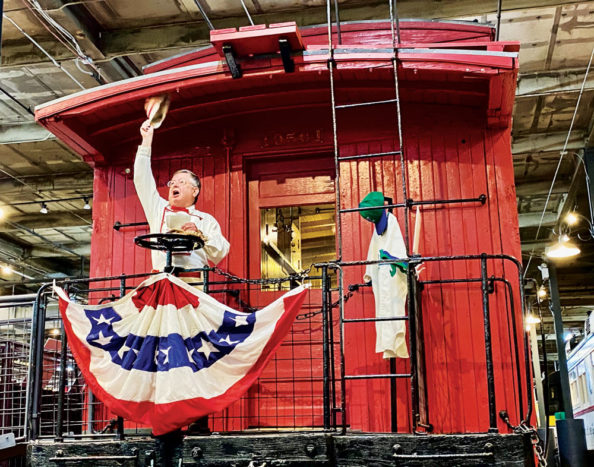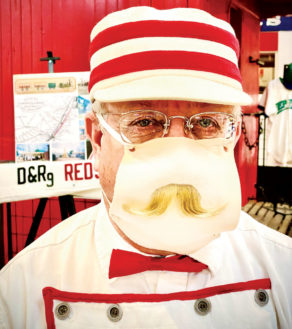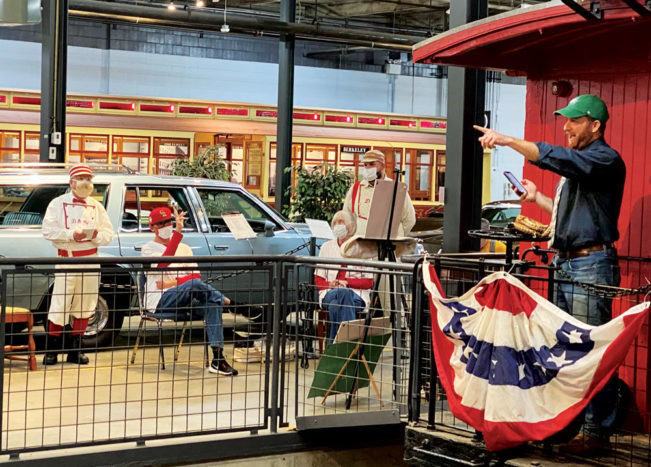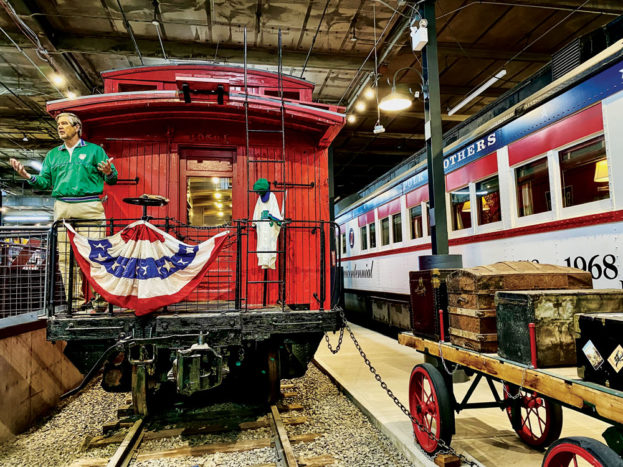
Paul Caputo expounds on his theory that “you can tell the story of the United States by understanding where minor league baseball teams got their nicknames,” many of which are based on the railroad industry.
Baseball and trains have a shared history in the U.S. From the early days of baseball until the 1950s, baseball teams traveled by train and many teams were named for train lines.
A collaborative presentation of the National Ballpark Museum and the Forney Museum of Transportation, “Where Baseball Hits the Tracks” treated about 30 visitors to some entertaining history about America’s pastime.

Vintage baseball player Roger Hadix closes his talk on “our national pastime” and its connection with railroads, with a rousing “Hip Hip Huzzah,” at the Forney Museum of Transportation.
Colorado Springs sports historian and author Roger P. Hadix wore a replica uniform of the 1882 Denver & Rio Grande Reds baseball team, a team comprised of D&RG employees that played in Colorado Springs. This upcoming season will mark his 27th season with the organization. His vintage team plays by the rules of 1864, when teams played barehanded, and a ball could be caught on one bounce for an out.

Roger Hadix sports a vintage baseball uniform and handlebar moustache, fashionably worn by 1880s players.
Hadix spoke of a time in 1888 when Albert Spalding took his Chicago White Stockings and an all-star team to Denver for two matches then rode the D&RG to Colorado Springs. Both teams played poorly and left after six innings—with all the gate receipts! “Colorado Springs felt cheated and telegraphed the next town in Utah and told them to watch out for those charlatans.”
Paul Caputo, deputy director of the National Association for Interpretation based in Fort Collins, gave a talk on the nicknames of minor-league baseball teams. He told of the Bowling Green Hot Rods, who play in Bowling Green, Kentucky, where Chevrolets are manufactured, and who have the alternate nickname of Sinkholes; a sinkhole there once “swallowed up 14 Corvettes.”
Caputo related how the Rocky Mountain Vibes in Colorado Springs got their name. A name-the-team contest resulted in the Rocky Mountain Happy Campers, but three weeks before they were due to unveil their logo, the president of minor league baseball learned of a nearby marijuana dispensary called the Rocky Mountain Happy Campers, and the team could not use that name.

An expert on names of baseball’s minor league team names, Paul Caputo acknowledges an audience member who has attended many of those teams’ games.
“But we can’t tell the history of the United States without trains,” Caputo said, and mentioned 11 minor-league teams with train-based logos, including the Bakersfield Train Robbers, the Omaha Golden Spikes—named for the final, golden spike that joined two railroads in Utah, thereby forming the Transcontinental Railway—and the Denver Zephyrs. “The word ‘zephyr’ means ‘gentle westerly wind,’ but the Denver Zephyrs team was named for the passenger train that traveled from Denver to Chicago from 1936 to 1973.”

Former Colorado Rockies pitcher Mark Knudson explains, “Major league players still congregate for card games, as they did on the trains. That camaraderie was born on the train, which became an extension of the club house, where team bonding happened.”
Speaker Mark Knudson is a right-handed pitcher who helped the Denver Zephyrs win the American Association championship in 1991 and was the first hometown product to play with the Colorado Rockies in their 1993 inaugural year.
“I sold tickets in the parking lot at Mile High Stadium when I was in high school,” Knudson said. “I was at the game on July 4, 1982 when the Denver Bears drew 65,666 for the annual Fireworks Game, a minor-league record for a single game.” The Denver Bears changed their name to the Denver Zephyrs in 1984, after nearly 30 years as the Bears. “Playing for the Zephyrs was a thrill for me. I’d grown up sitting in the stands and then had the chance to play on the field, knowing that it was just a matter of time before Denver would become a major-league city.”
Rail routes began giving way to air routes by the mid-1950s. By the time the renamed Los Angeles Dodgers and San Francisco Giants played their first games on the West Coast in 1958, traveling by air had become more practical.
Front Porch photos by Steve Larson


0 Comments